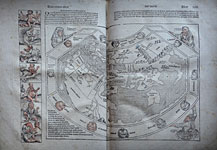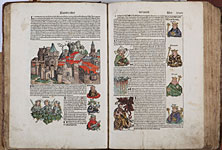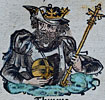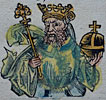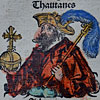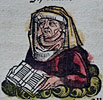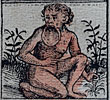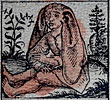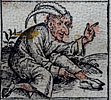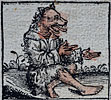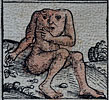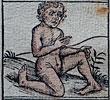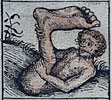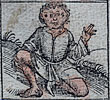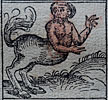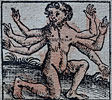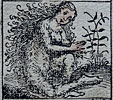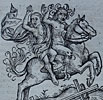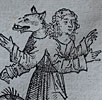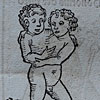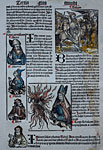Journey from the 15th Century to the Distant Past:
«Book of Chronicles from the Creation of the World with Figures and Images»
Among the most noteworthy items in the collection of early printed books of the National Library of Russia is the Book of Chronicles (Liber cronicarum) by the medical doctor, historian and humanist Hartmann Schedel.
It is one of the most important and most famous incunabula (publications before 1501). This beautiful, lavishly illustrated work of art was first published in Latin in 1493 in Nuremberg, using the latest technological advances.
The book is better known as the Nuremberg Chronicle. Scholars also refer to it as Schedel's Chronicle or the World History. It became very popular among educated people in Europe in a very short time. The large folio volume (measuring 47х32 cm) with 286 pages of text has a great commercial success and became one of the first "best celler". The Chronicle was published in two editions in the same year: the first 1000 Latin copies printed in July (all of them were sold) were followed by 1000 German copies with the same illustrations a few months later, in December.
This magnificently designed and printed masterpiece was issued by the enterprise of the outstanding printer Anton Koberger who has 24 presses in operation and employed up to 100 workers: typesetters, printers and proofreaders and so on. Koberger was first to deal with questions that had never arised before in smaller format editions: how best to integrate illustrations and text, how to arrange them on a page successfully and make a space between text and images smaller. The printery coped brilliantly with the tasks.
«Liber cronicarum» is an illustrated compilation of historical and geographical data borrowed from the Bible, the works of ancient historians, medieval chronicles and combined with the author's original view of the events of contemporary history.Readers have received the universal history of the world with great pictures. It was very different from those of that time: the scholastic Speculum historiale (Mirror of History) by Vincent of Beauvais or the most popular brief encyclopedia of history of the 15th century Fasciculus temporum (Bunch of times) by Werner Rolewinck, representing the events that took place simultaneously in different countries, or a chronicle of one city ( a lot of them were produced at that time).
The author was not a scholar-monk or a university professor: Hartmann Schedel (1440-1514) worked as a physician. He was born in Nuremberg in 1456, and educated at the University of Leipzig where he received a bachelor's degree in psychology and then a master's degree. In December 1463, a young man moved to Italy to study medicine at the University of Padua. Schedel practiced medicine for many year in different cities of Germany, and in 1484, he succeeded his uncle Herman Schedel as the city doctor in Nuremberg.
In Nuremberg, he entered the circle of the notable scholars and artists, one of the most famous German humanist groupes of his time. For the first ten years of work in Nuremberg, Schedel wrote his major historical work. In the 1493 Nuremberg edition, its title is given in the beginning of the text, 'The contents of this work is the Book of Chronicles from the creation of the world with figures and images'.The huge volume contains 1809 (!) splendid woodcuts which much contributed to the widespread popularity of the book. The majority of illustrations are portraits, 4 - 5 per page, but among them are quite a few scenes depicting the construction of Noah's Ark, the camp of Taborites, the 1566 Constantinople earthquake and so on, and many diagrams (hail, comet, locusts, etc.) Particularly fascinating are the large, double-page city views. The views of German towns, including Nuremberg, are the most authentic. For instance, outside the walls of Nuremberg, you can see Stromer's paper mill which supplied paper for many publishers, and it is this mill at that the paper for the Chronicle was made.
Views of European cities were filled with detail: they show the location of the main buildings, cathedrals and fortified towers and so on extremely accurately. Today, they are invaluable historic sources, because many significant pieces of architecture were lost over time.However, the pictures of biblical characters or heroes of antiquity certainly could not be accurate and reliable, as well as the images of dozens of popes, emperors and kings, saints and scholars are also invented. A likeness is achieved only in portraits of persons of the recent past. This makes the difficult task of illustrators much simpler: they didn’t need to make two thousand wooden blocks. The painters Wilhelm Pleydenwurff and Michael Wolgemut (Albrecht Dürer was his apprentice and is supposedly contributed woodcuts to the Chronicle) provide only 645 original blocks for the Chronicle. Many of the woodcuts were used more than once in the book. The same portrait represents several different men: once it was an Old Testament prophet, another time it stood for a Greek philosopher or Roman poet and, at last, it was repeated again as a scholar or Arab doctor.
Twenty eight wooden blocks were used to depict 198 popes mention by Schedel, and portraits of 224 kings from different countries were produced from a groupe of 44 woodcuts. The prints are traditional and sometimes very naive - they feature the creation of Adam from clay and Eve out of Adam's rib, diverse dog-head or one-eyed monsters "lived before the flood", "divine signs" - comets, auroras, etc. Many pictures represent kings, bishops, scholars, physicians, and so on, holding attributes of their authority (scepter and orb, crozier…) or symbols of their profession (a book, an astrolabe, a chessboard…). The most amusing are portraits of persons wearing eyeglasses or holding a pair of spectacles in their hands.
The text was written in a style that can be easily read and understood. It begins with the creation of the wold and the story of the expulsion from Paradise, then presents other events of the Old Testament supplemented with the tales of the Trojan War and the campaigns of Alexander the Great, etc.
The contents of the Chronicle are divided into sixthth ages: human history is interpreted as a linear progression from the creation of the world. The sixth age covers the period from the birth of Christ to the perpetually-changing present, it occupies more space in the book than the previous five. The final, seventh age is described as the age of the Anti-Christ, the anticipated Last Judgement and the destruction of the earthly state. And since the sixth age had not ended yet, the book had some blank leaves. They gave the future owner space to record the rest of the history after the publication of the book.
Among the most notable illustrations is the Dance of Death which is accompanied by a statement that only death equalizes all social classes. Despite the author was well educated man, he included "all the medieval legends, fables, all superstitious beliefs rejected and condemned by Italian humanists, contemporary to him,…" in the book. To illustrate this "information", there were made original prints depicting mythological human monsters: dog-headed or two-and three-headed creatures; monsters devoid of mouth; monopods with a single leg ending in a huge foot that so large they could lay on their backs and protect themselves against sunlight by the shade of their feet.Historians have found out that most of the texts of the World Chronicle are extracts from various authors represented in Schedel's rich personal library. Among others, the Chronicle includes a quotation from History of Europe by the Italian humanist Enea Silvio Piccolomini (the future Pope Pius II) and a short historical and geographical essay About the European Region Sarmatia: they are placed on unnumbered pages in the 1493 Nuremberg edition. This additions were unchanged in subsequent editions of the book. The essay About the European Region Sarmatia is attributed to a German poet and humanist Konrad Celtis, this assumption is confirmed by the poetic ending of the last section. The author defines the boundaries of Sarmatia according to the ancient geographers: its territory includes Russia, Grand Duchy of Lithuania and Poland. While it is clear that he could not exactly imagine the proportions of these parts.
The Nuremberg Chronicle has a detailed index: the index of names contains not only the list of the emperors, kings, bishops and popes but also physicians and philosophers, language experts and other intellectuals. The index also includes geographical names, a list of concepts and references to specific historical events.
It is no exaggeration to say that Schedel's Chronicle is the best documented early printed book, because many of contracts, related to it, are still extant, including the original agreement for the preparation of the book, dating back to 1491; contracts for its production, and bills recording sales until 1509. Responding to a demand for a book, the publisher Johann Schönsperger from in Augsburg released three more editions of the Chronicle in a smaller size. In 1496, he printed German copies and, in 1497, issued his Latin edition which was followed in 1500 by another German edition.
The National Library of Russia possesses 19 copies of the «Liber cronicarum»: these include 6 copies of the Latin edition published in Nuremberg on 12 July 1493; 4 copies of the German edition issued in Nuremberg on 23 December 1493; 3 copies of the Augsburg German edition printed on 18 September 1496; 5 copies of the Augsburg Latin edition released on 1 February 1497; one copy of the 1500 Augsburg German edition. Some of the copies are hand coloured. Noteworthy is a Latin copy from the Zaluski brothers collection, which was presented to the Imperial Library (the former name for the National Library of Russia) by the heirs of A. Venevitinov in 1885. The German copy, originating from the Jesuit College of Regensburg (Ratisbon), carries numerous readers' notes made during the 16th and 17th centuries.

